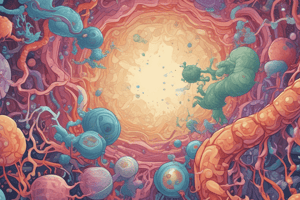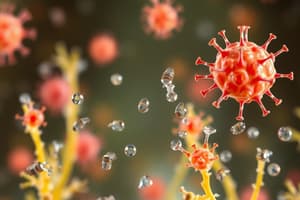Podcast
Questions and Answers
Which of the following statements accurately describes the structure of a bacterial cell wall?
Which of the following statements accurately describes the structure of a bacterial cell wall?
- The cell wall is composed of a single layer of phospholipids and proteins, which are arranged in a bilayer.
- The cell wall is composed of a single layer of cellulose, which is a complex carbohydrate.
- The cell wall is composed of a single layer of peptidoglycan, which is a rigid polymer of sugars and amino acids.
- The cell wall is composed of two layers: an outer membrane and an inner peptidoglycan layer. (correct)
What is the main difference between a retrovirus and other viruses?
What is the main difference between a retrovirus and other viruses?
- Retroviruses have a double-stranded DNA genome.
- Retroviruses are able to integrate their genetic material into the host's genome. (correct)
- Retroviruses have a single-stranded RNA genome that is directly translated into proteins.
- Retroviruses are only able to infect bacteria.
Which of the following factors does NOT contribute to pathogenicity?
Which of the following factors does NOT contribute to pathogenicity?
- The ability of the host to produce antibodies against the pathogen. (correct)
- The ability of the pathogen to adhere to host cells.
- The ability of the pathogen to evade the host's immune system.
- The ability of the pathogen to produce toxins.
Which of the following is NOT an example of a non-living pathogen?
Which of the following is NOT an example of a non-living pathogen?
Which type of antibiotic targets the synthesis of bacterial cell walls?
Which type of antibiotic targets the synthesis of bacterial cell walls?
Flashcards
Microbiota
Microbiota
The community of microorganisms living in a particular environment, especially the human body.
Endospore
Endospore
A tough, dormant structure formed by some bacteria for protection against harsh conditions.
Types of antibiotics
Types of antibiotics
Different categories of antibiotics that target bacterial growth or kill bacteria; examples include penicillins, tetracyclines, and macrolides.
Prion infection
Prion infection
Signup and view all the flashcards
Pathogenicity factors
Pathogenicity factors
Signup and view all the flashcards
Study Notes
Microbiota
- Microbiota refers to the collection of microorganisms, including bacteria, fungi, viruses, and archaea, that naturally inhabit various environments in and on the human body.
- These microbes play crucial roles in human health, contributing to numerous physiological processes.
Historically Significant Figures in Microbiology
- Louis Pasteur: Developed crucial methods for preventing disease. Notably, he pioneered pasteurization and identified the role of microorganisms in fermentation.
- Robert Koch: Formulated postulates that link specific microbes with specific diseases.
- Joseph Lister: Introduced antiseptic techniques into surgery.
Pathogens (Living and Non-living)
- Living Pathogens: Bacteria, viruses, fungi, protozoa, and parasites.
- Non-living Pathogens: Prions.
Bacterial Cell Wall Structure
- The bacterial cell wall is a rigid structure, providing support and shape.
- It's primarily composed of peptidoglycan, a unique polymer of sugars and amino acids.
- Layers of peptidoglycan vary, contributing to different types of bacteria (Gram-positive or Gram-negative).
Endospores
- Endospores are highly resistant, dormant structures formed by certain bacteria.
- They offer a protective layer that allows the bacterium to survive harsh conditions.
- Composed of layers of proteins, ensuring an extremely resistant structure.
Types of Antibiotics
- Antibiotics are medications that impede or halt bacterial growth.
- They target different bacterial components, like the cell wall or protein synthesis.
- Different types target various bacterial processes, each affecting either bacterial growth or bacterial replication.
Discovery of Antibiotics
- Antibiotics were discovered through observation of the natural world—the presence of antibacterial properties in certain organisms or environments.
- Examples include the mold producing penicillin.
- Penicillin is extracted from certain molds, particularly Penicillium species.
Virus Structure
- Viruses have an outer capsid (protein coat) surrounding the genetic material (DNA or RNA).
- The capsid protects the viral genome and assists in infection.
- The genetic material carries the instructions for viral reproduction.
Retroviruses
- Retroviruses, like HIV, have RNA as their genetic material.
- They use an enzyme called reverse transcriptase to convert RNA into DNA, a process unique to this type of virus.
- This DNA is then incorporated into the host cell's DNA.
Prions
- Prions are misfolded proteins that cause other normal proteins to misfold as well.
- This misfolding leads to cell damage and ultimately, to disease.
- Prion diseases are uniformly fatal.
Factors Determining Pathogenicity
- Virulence: The capacity of a pathogen to cause disease, encompassing factors such as the strength of the pathogen.
- Infectivity: The ability of a pathogen to invade and multiply in the host.
- Invasiveness: The ability of a pathogen to spread from the initial site of infection to other parts of the host.
- Toxin Production: Some pathogens produce toxins that damage the host tissues, triggering an immune response and damage.
- Adherence: The ability of a pathogen to attach to susceptible host cells.
Studying That Suits You
Use AI to generate personalized quizzes and flashcards to suit your learning preferences.





